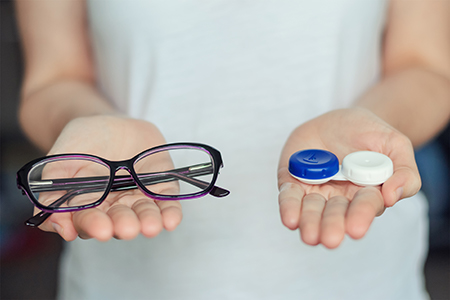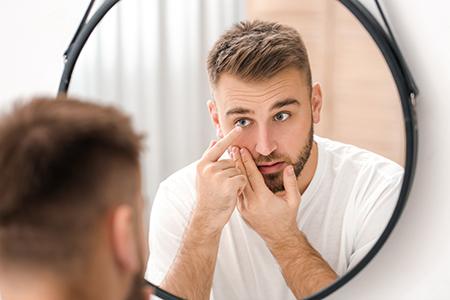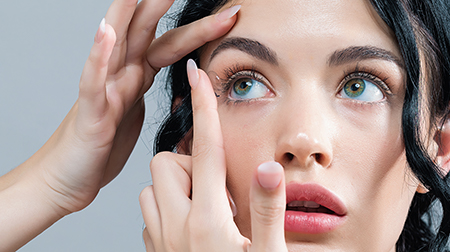New Patients
Existing Patients
New Patients
Existing Patients
New Patients
Existing Patients
New Patients
Existing Patients
New Patients
Existing Patients
New Patients
Existing Patients
New Patients
Existing Patients
New Patients
Existing Patients

Contact lenses have evolved into a versatile, modern solution for many vision needs. Advances in lens materials and manufacturing mean lenses are softer, more breathable, and available in a wide range of corrective and cosmetic designs. For people who want a natural field of view, freedom from frames, or the convenience of sport- and activity-friendly vision correction, lenses are often an excellent option.
Choosing to try contact lenses is a personal decision rooted in daily habits and visual priorities. Some wear them full-time, others as an occasional complement to eyeglasses. Regardless of how you plan to use them, a carefully conducted contact lens exam ensures that lenses will perform comfortably and safely for the way you live.
Contacts address the most common refractive errors, including nearsightedness (myopia), farsightedness (hyperopia), astigmatism, and age-related presbyopia. Because the lens sits directly on the eye, measurements and fitting are more precise than glasses alone, which is why a dedicated contact lens evaluation is essential before you begin wearing lenses.

A contact lens exam goes beyond a routine vision check. In addition to measuring your refractive error, the clinician evaluates the surface of the eye, tear film quality, and corneal shape. These findings help determine whether soft, rigid, or specialty lenses are appropriate and whether your eyes are healthy enough for safe contact lens wear.
Your practitioner will take specific measurements — such as corneal curvature and pupil size — and may use diagnostic lenses to test fit and comfort. Trial lenses allow the doctor to assess how a lens moves on the eye, how it affects vision at different distances, and how your tear film interacts with the lens surface through the day.
Because contact lenses sit on the eye instead of a few millimeters away like glasses, the exam also includes instruction on insertion, removal, and daily care. Proper handling and adherence to recommended wear schedules dramatically reduce the risk of irritation and infection and improve your overall success with lenses.
Selecting the correct lens design is a balance of prescription, eye anatomy, and personal routine. Factors such as how many hours you wear lenses daily, whether you work at a computer, play sports, or need multifocal correction for both near and far tasks all influence the recommendation. The clinician will discuss trade-offs and help you select a solution that aligns with your priorities.
Medical and environmental considerations play a role as well. Dry eye, seasonal allergies, or a history of corneal conditions can steer the choice toward materials and replacement schedules that maintain ocular comfort. Budgetary constraints and ease of care are also practical aspects that inform the final plan, always with an emphasis on ocular health.
For people with unique corneal shapes or a history of refractive surgery, specialized lens designs exist to restore crisp vision without compromising comfort. The goal of the fitting process is to match a lens to the eye’s anatomy so wear is sustainable and vision performance meets expectations throughout the day.
Soft contact lenses, crafted from hydrogel or silicone hydrogel materials, are the most commonly prescribed option because of their comfort and adaptability. These lenses conform to the eye’s surface and are available in daily, biweekly, or monthly replacement schedules to suit different maintenance preferences.
Daily disposable lenses are worn once and discarded at the end of the day. They eliminate the need for cleaning solutions and reduce the chance of buildup or deposit-related irritation, making them an attractive option for people seeking a straightforward, hygienic approach to contact lens wear.
Some lenses are designed for extended wear and can be worn overnight for short, specific periods. These lenses are made from oxygen-permeable materials that support corneal health during sleep, but extended wear requires careful assessment and ongoing monitoring to manage infection risk and ensure safe long-term use.
RGP lenses are firmer than soft contacts and hold their shape on the eye, which can result in very crisp vision, especially for people with irregular corneas or higher prescriptions. They are durable, resist deposits, and often require fewer replacements over time, though an adjustment period is common as the eye adapts.
Toric lenses are engineered to correct astigmatism by incorporating different powers across lens meridians. They can be produced as soft or rigid designs and are fitted to remain stable on the eye so the corrective axis aligns consistently with the cornea.
Multifocal and bifocal contact lenses offer simultaneous or segmented powers to help the eye focus at multiple distances. These lenses are a common alternative to reading glasses, and many patients find they provide a seamless transition between near and far tasks once they adapt to the visual experience.
Monovision uses single-vision lenses with one eye corrected for distance and the other for near tasks. It can be an effective strategy for some patients who struggle to adapt to multifocal designs; a trial fitting helps determine whether monovision will meet your visual demands.
Colored and tinted lenses are available to subtly enhance or dramatically change eye color while providing vision correction when needed. Because they are still medical devices, these lenses require a fitting and prescription to ensure safe, comfortable wear.

Not every eye accepts standard lenses immediately. Factors that can complicate fitting include unusual corneal shape, significant astigmatism, dry eye, surface scarring, or the aftereffects of refractive surgery. Conditions such as keratoconus or pellucid marginal degeneration often require specialty or custom-designed lenses to achieve comfortable, usable vision.
Examples of common fitting challenges include:
Unusual corneal curvature or scarring
Significant astigmatism
Presbyopia and difficulty with near tasks
Chronic dry eye or ocular surface disease
Inflammatory conditions such as giant papillary conjunctivitis
Changes after refractive surgery like LASIK
Even when a fit is challenging, modern lens options and experienced fitting strategies usually produce a workable solution. The fitting process may include multiple visits, refinements to lens parameters, and consideration of specialty materials that improve comfort and sight.
Long-term success with contacts depends on consistent care: proper cleaning (when using reusable lenses), following prescribed replacement schedules, and removing lenses when irritation or vision changes occur. Annual contact lens evaluations are important to confirm that your lenses still fit well and that your eyes remain healthy under wear conditions.

Contact lens wear can offer freedom, clarity, and an unobstructed field of view when chosen and fitted correctly. A thorough contact lens exam assesses both vision and ocular surface health, allowing your clinician to recommend the most appropriate materials and wearing schedules for your needs.
If you have questions about whether contacts are a good match for your vision, or if you’ve struggled to find comfortable lenses in the past, an individualized evaluation is the best next step. At Harvard Square Eye Care we tailor fittings to the person, not just the prescription, so vision and comfort work together.
To learn more about contact lens exams and fitting options or to discuss what might work best for your eyes, please contact us for more information.
A contact lens exam includes everything in a comprehensive eye exam plus specific tests to ensure lenses will fit and function on the ocular surface. In addition to measuring refractive error, the clinician evaluates corneal shape, tear film quality, and the overall health of the ocular surface. These added steps allow the doctor to select appropriate lens materials and designs that match your eyes and lifestyle.
Because contact lenses sit directly on the eye, measurements such as corneal curvature and pupil size are taken to refine lens choice and fit. Trial lenses are often used to confirm comfort, vision at different distances, and how the lens interacts with your tear film through the day. Instruction on insertion, removal, and lens care is also provided to promote safe, successful wear.
A fitting typically includes keratometry or corneal topography to measure corneal curvature, pupil and limbal measurements, and a detailed assessment of the tear film and eyelid function. These objective parameters guide the selection of base curve, diameter, and lens design so the lens aligns properly with the cornea. The clinician will also check for any surface irregularities, scarring, or signs of ocular surface disease that could affect fit and comfort.
After initial measurements, diagnostic or trial lenses are used to observe lens movement, centration, and stability on the eye while assessing visual quality at near and distance. Measurements may be refined during follow-up visits to optimize parameters and wearing schedule. This iterative approach helps reduce irritation and improves long-term success with contact lenses.
Choosing a lens balances prescription needs, eye anatomy, daily routine, and personal preferences for care and replacement schedules. Factors such as hours of daily wear, screen time, sports or outdoor activity, and the need for multifocal correction influence whether soft daily disposables, reusable lenses, RGPs, or specialty designs are recommended. The clinician will discuss trade-offs like convenience versus long-term ocular surface compatibility to align the choice with your priorities.
Medical and environmental conditions—dry eye, allergies, or past corneal surgery—also affect material and replacement recommendations, as some materials better retain moisture or resist deposits. A trial period with follow-up ensures the selected lens meets comfort and vision expectations before committing to a long-term plan. If you have specific concerns or questions about lens options, the practice can tailor recommendations to your routine and ocular health.
Common options include soft hydrogel and silicone hydrogel lenses, daily disposables, reusable monthly or biweekly lenses, rigid gas-permeable (RGP) lenses, toric lenses for astigmatism, and multifocal designs for presbyopia. Soft lenses conform to the cornea and are known for initial comfort, while RGPs provide sharper optics for irregular corneas and are more durable. Toric and multifocal lenses address specific refractive needs like astigmatism and age-related near-vision loss, respectively.
Daily disposables offer hygiene and convenience by eliminating cleaning routines, whereas reusable lenses require a care regimen and regular replacement to avoid deposits. Extended-wear lenses exist but require careful medical assessment and monitoring due to increased infection risk during overnight wear. Your clinician will explain the benefits and limitations of each type to help you choose the best fit for vision and lifestyle.
Before prescribing lenses, the clinician performs a thorough anterior segment exam to look for signs of dry eye, inflammation, corneal staining, scarring, or infection risk factors. Tear film quality is assessed using tests that may include tear breakup time, staining with fluorescein, and evaluation of the lid margins and meibomian glands. These findings determine whether additional treatment is needed before initiating or continuing contact lens wear.
If ocular surface disease is present, the exam may result in treatment recommendations such as lid hygiene, lubricants, or medical therapies to improve comfort and lens tolerance. Regular follow-up visits are scheduled to monitor the eye’s response to lenses and to catch early changes that could compromise health. Maintaining ocular surface health is a core part of ensuring safe, long-term contact lens use.
Yes, many modern contact lens designs address astigmatism and presbyopia, and specialized options exist for eyes that have undergone refractive surgery. Toric lenses stabilize the optical axis for astigmatism, while multifocal or bifocal lenses and monovision strategies help manage presbyopia depending on patient preference and visual demands. Eyes that have had LASIK or similar procedures may need custom or specialty lenses to account for altered corneal shape.
Patients with irregular corneas or significant post-surgical changes may be fitted with custom rigid or hybrid lenses that provide clearer vision and better fit. The fitting process for these conditions is more involved and may require multiple visits and lens refinements to achieve optimal comfort and acuity. Your clinician will outline realistic expectations and the fitting steps needed for your specific situation.
Contact lens wear carries potential risks such as irritation, infection, corneal inflammation, and hypoxia if lenses are not properly fitted or cared for. Many risks are reduced through proper hygiene, adherence to recommended replacement schedules, avoidance of overnight wear unless approved, and by removing lenses at the first sign of pain or significant vision change. Regular follow-up exams help detect early signs of complications so they can be addressed before long-term damage occurs.
Patients should follow handling and disinfection instructions closely and avoid behaviors that increase risk, such as swimming while wearing lenses or sleeping in lenses not approved for overnight use. Prompt communication with your eye care provider about redness, discharge, or blurred vision ensures timely evaluation and treatment. The aim of the contact lens exam process is to minimize risk while enabling safe, comfortable wear.
Care recommendations depend on lens type but generally include proper handwashing before handling lenses, following manufacturer and clinician instructions for cleaning and disinfection with reusable lenses, and adhering to the prescribed replacement schedule. Daily disposables require minimal care beyond disposal after use, while reusable lenses need regular cleaning, case hygiene, and replacement of the storage case. Avoiding makeup contamination and replacing lens cases regularly are simple steps that reduce infection risk.
Follow-up visits after a new fitting ensure lenses continue to fit well and that the ocular surface remains healthy under wear conditions. Annual contact lens evaluations are recommended at minimum, with more frequent checks for patients using specialty lenses or those with ocular surface disease. Reporting any discomfort or vision changes between scheduled visits allows the clinician to intervene quickly and refine the plan as needed.
Difficult fits often benefit from specialty lens designs including custom rigid gas-permeable lenses, scleral lenses, hybrid lenses, or custom soft lens options that vault or conform to irregular corneas. Scleral lenses, for example, rest on the less sensitive sclera and create a fluid reservoir that can improve comfort and vision for keratoconus or severe ocular surface disease. These lenses typically require advanced diagnostic fitting and close follow-up to achieve optimal results.
Fitting for complex corneal conditions may require multiple visits, custom parameters, and sometimes lens modifications to balance vision, comfort, and ocular health. Collaborating with an experienced clinician and committing to the fitting process increases the likelihood of a successful, wearable solution. The practice has experience coordinating specialty fittings and can recommend a tailored approach based on your corneal shape and vision goals.
Begin by scheduling an appointment for a contact lens evaluation at one of the practice locations so the clinician can perform a comprehensive assessment and discuss your goals for lens wear. The exam will include diagnostic measurements, trial lens fitting as appropriate, and hands-on instruction for insertion, removal, and care to ensure you leave with the skills needed for safe wear. A follow-up visit is typically arranged to confirm fit, comfort, and visual performance after a trial period.
If you have had difficulty finding comfortable lenses in the past or have special needs such as high astigmatism or post-surgical corneas, mention this when booking so the office can allocate appropriate time and resources. Clear communication about your daily routine and visual priorities helps the clinician select suitable options and design an effective fitting schedule. Contact Harvard Square Eye Care to arrange an evaluation and start the fitting process.

Quick Links
Contact Us